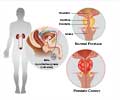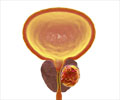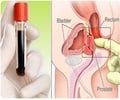- Bothersome Hot Flashes Following Neoadjuvant Androgen Deprivation Therapy and Stereotactic Body Radiotherapy for Localized Prostate Cancer - (https://pmc.ncbi.nlm.nih.gov/articles/PMC10998655/)
- Hot flushes when having hormone therapy for prostate cancer - (https://www.guysandstthomas.nhs.uk/health-information/hot-flushes-hormone-therapy-for-prostate-cancer#)
- Hot flushes in men - (https://www.cancerresearchuk.org/about-cancer/prostate-cancer/practical-emotional-support/hormone-symptoms/sex-hormones-hot-flushes/)
About
Men undergoing treatment for prostate cancer might have to undergo hormone deprivation therapy. This hormone therapy for prostate cancer can alter the amount of sex hormones in the body and can cause hot flushes.
What are Hot Flushes?
Hot flushes are characterized by abrupt waves of strong heat and a flushing sensation throughout the face and torso. They are frequently accompanied with perspiration. Hot flushes might last from a few minutes to a half hour. They can occur infrequently or on a regular and recurrent basis throughout the day and night.
Did You Know?
While hot flushes are common in women, men undergoing hormone therapy for prostate cancer can also experience these intense heat waves! #prostatecancer #hormonetherapy
Incidence of Hot Flashes in Prostate Cancer
Almost 52% of patients undergoing hormone deprivation therapy reported hot flashes as being a moderate to big problem during prostate cancer treatment(1✔ ✔Trusted Source
Bothersome Hot Flashes Following Neoadjuvant Androgen Deprivation Therapy and Stereotactic Body Radiotherapy for Localized Prostate Cancer
Go to source).
How do Hot Flushes Feel?
Hot flushes might differ from one person to another. They can be uncomfortable and debilitating. Hot flushes can make one feel extremely heated and overwhelmed. A person may start sweating and also feel shivers as the sweat dries on the skin's surface.
They can begin as a sensation of warmth in your neck or face. This frequently spreads to other areas of your body.
What are the Symptoms of Hot Flushes in Men?
Symptoms of hot flushes in men may include(2✔ ✔Trusted Source
Hot flushes when having hormone therapy for prostate cancer
Go to source):
- Skin redness
- Mild or excessive perspiration
- Palpitations (the sensation of your heart thumping in your chest)
- Feelings of panic or irritation
You may have a few each month or more frequently. The flushes normally last a few months, but some people have them for much longer periods. They can be disruptive and may make sleeping difficult.
What Causes Hot Flushes in Men?
Hot flushes are typical with hormone deprivation therapy for prostate cancer.
How Does Hormone Therapy Lead to Hot Flushes?
Hormones occur naturally in the body. They regulate the proliferation and activity of normal cells. Testosterone is a male sex hormone primarily produced by the testicles. Prostate cancer typically relies on testosterone to flourish. Hormone therapy inhibits or reduces the level of testosterone in the body.
Lowering the testosterone levels can help control or treat prostate cancer. This is known as hormone deprivation therapy (or androgen deprivation therapy) and can be accomplished with surgery, injections, or tablets. Hot flushes are a side effect of low testosterone.
Distinct hormone therapies have distinct adverse effects. Most men get hot flushes after receiving certain therapies, such as goserelin (Zoladex). Other medications, such as bicalutamide, are less likely to trigger hot flashes.
Many men get hot flushes that improve gradually over several months. Others get flushes that endure the duration of their treatment. They do tend to occur less frequently over time.
Management of Hot Flushes in Men
Identifying the Triggers for Hots Flushes
Hot flushes might be induced by certain meals, beverages, or surroundings. The first step in regulating hot flushes is to identify the triggers. Keep a diary for a few days and record what you eat and drink, as well as what you do when you have a hot flush. If you can identify the triggers, you may be able to avoid, limit, or mitigate their consequences. Common triggers include include spicy foods, alcohol, coffee, stress, smoking, overheated rooms, and hot weather.
Managing Stress
Many men report that stress increases the frequency and severity of their hot flushes. Relaxation, exercise, massage, meditation, and acupuncture are some of the methods for stress reduction.
Managing the Environment
- Dress in layers so you can remove items as you warm up. Wear cotton, linen, or rayon instead of synthetic textiles or wool.
- Avoid polo neck tops and go for open-neck shirts whenever possible.
- Carry a bottle of cool water to drink.
- Keep your home cool. Turn the heat on lower or use a fan. When you go out, you may also want to bring a hand-held battery-operated fan. Even inexpensive paper fans can assist.
- Wear cotton pyjamas or a nightshirt. If you sweat excessively at night, your nightclothes are easier to change than your sheets.
- Use only cotton bedding, no synthetics.
- Take a cold-water shower before bedtime.
- A cooling cushion insert may help.
Diet to Manage Hot Flushes in Men
Try avoiding meals and drinks that cause flushes, such as spicy foods, caffeine-based beverages, and alcohol.
Quit Smoking
If you smoke, try to quit. Speak with your nurse or doctor to provide assistance to help you quit smoking.

Alternative Therapies for Reducing Hot Flushes in Men
There is limited empirical evidence that complementary therapy can relieve hot flushes in men with prostate cancer. If you are thinking about adopting complementary or alternative therapies, see your cancer doctor, general practitioner, or specialized nurse.
- Herbal medicines: Some herbal medications claim to cure hot flushes, but there is little evidence to support their efficacy or safety. Herbal drugs may interact with other medications, or they may have negative effects that render them ineffective. Always consult your nurse or doctor before starting with any alternative medicines for hot flushes.
- Acupuncture: Small studies imply that acupuncture causes less severe hot flushes.
- Cognitive behavior therapy: This approach implies that there is a connection between your ideas and actions. It emphasizes on relaxing your body and mind while maintaining a pleasant mindset. This may relieve hormonal symptoms like hot flushes.
Drugs Treatments for Management of Hot Flushes
Some medications have been proven to lower the frequency and intensity of flushes, although the data is limited, and none are licensed for this purpose.
If you have tried the above home remedies for hot flushes and have not found relief, you might talk to your doctor or specialist nurse about the possibility of using medication. Every medicine has adverse effects, and not all medicines are appropriate for everyone.
Here are some medicines that might help treat hot flushes in men(3✔ ✔Trusted Source
Hot flushes in men
Go to source):
- Medroxyprogesterone: It belongs to the class of drugs known as progestogens. This is typically the primary choice of treatment. You take 20 mg every day for ten weeks. After ten weeks, your doctor should reassess this medicine.
- Cyproterone: If medroxyprogesterone has not been effective for you, your doctor may recommend cyproterone acetate. You normally take 50 mg per day, but your doctor can increase the dose to 150 mg if necessary.
- Antidepressant medications: Certain antidepressants like venlafaxine and paroxetine have been proven in studies to help treat hot flushes in men with prostate cancer.
- Gabapentin: It is a medication prescribed to treat epilepsy and nerve pain. It can also be useful in regulating hot flushes; however, this is uncommon.
- Other prostaglandins: If earlier therapies have not worked for you, your doctor may suggest trying another form of progesterone. One such example is megestrol acetate (Megace).









